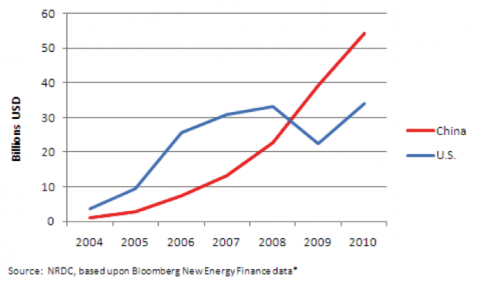In a recent post we examined the remarkable growth of renewable energy in China — and the rising importance of climate change, energy security and low-carbon development in government decision-making. Here we will offer a quick look ahead at what lays in store for the next five years.
The 12th Five-Year Plan
On March 5th, Chinese Premier Wen Jiabao introduced the draft of the country's next Five-Year Plan, covering 2011-2015, at the opening of the current session of the National People's Congress (China's NPC is a parliament of sorts).
China's Five-Year Plans are national frameworks that lay out the goals the government intends to achieve over the next five years. Details are elaborated throughout the five years as policies are implemented to achieve the objectives, which are typically binding on regions and ministries. The final Five-Year Plan was endorsed on March 14th after being reviewed by the NPC. (Some interesting background on how the plan was developed can be found here).
"What is striking about China's plans for low carbon growth is how they underpin the next phase of the country's economic development. Cutting carbon intensity is not just an environmental objective, but a way of driving up the competitiveness of core industrial sectors."
— Nick Robins, Head, HSBC Climate Change Centre of Excellence
As readers of our previous post on China may recall, many analysts predicted that low-carbon development would be at the core of the latest Five-Year Plan. The government is seeking to reshape economic development, boost alternative energy, reduce serious environmental impacts such as air and water pollution and meet its climate change commitments. Based on the details available so far, there's a strong case to be made that transitioning to lower-carbon development will indeed be a central goal of China's policy in the next five years.
China made the following significant commitments in its new Five-Year Plan. (Note that all targets are to be met by the end of 2015, relative to a 2010 baseline. They also broadly align with achieving 2020 commitments made under the Copenhagen Accord.) China's government plans to:
- Reduce energy intensity, or energy consumed per unit of GDP, by 16 per cent. This is a "mandatory" target nationally and will be apportioned to regions and cities, which will be assigned legally-binding targets.
- Reduce carbon intensity (CO2 emitted per unit of GDP) by 17 per cent. This target will be mandatory in the same way as the energy intensity target above. This is the first time that China has set a carbon intensity target and, by building on the progress it has made since 2005, the 17 per cent target is roughly in line with China's Copenhagen commitment to reduce carbon intensity by 40-45 per cent by 2020 (relative to the 2005 level).
- Increase non-fossil energy sources to 11.4 per cent of primary energy consumption (mandatory target). For reference, the current level is 8.3 per cent and the 2020 target committed to in the Copenhagen Accord is 15 per cent.
- Set a more measured pace of GDP growth of 7 per cent year — 4.2 per cent less than the average over the past five years — in line with Premier Wen's recent comments that China "can no longer sacrifice the environment for the sake of rapid development and rash construction; this will only lead to production over-capacity, increased pressure on environmental resources and unsustainable economic growth."
It should be noted that China regularly exceeds its (non-binding) growth targets. However, targeting a slower pace of growth sends an important signal to local officials that rapid GDP growth is not the only way that the central government will assess their performance. (In China, national targets, such as those for energy and carbon intensity, are allocated to each region by the central government and it is up to local officials to ensure compliance with these targets or face censure. Local planning must therefore aim to achieve all of the objectives set by the central government. The rising importance of energy and carbon intensity as performance metrics means that these issues will become higher priorities in local decision-making.)
If you're looking for more detail on any of those goals, the Wall Street Journal has posted searchable scans of the key documents in English, and ChinaFAQs has a useful summary here. The Climate Group's detailed guide to the 12th Five-Year Plan is also excellent, as is E3G's analysis.
According to Zhang Guobao, an official who stepped down from his longtime position as China's energy czar in February, China will also place a cap on its total primary energy use during this Five-Year Plan — another first for the country. The cap would be set at 4 billion tonnes of coal equivalent, which would limit total energy consumption growth to 4.24 per cent per year to 2015, compared to growth of 5.9 per cent between 2009 and 2010. There is some uncertainty as to whether this goal will be mandatory or not but, as NRDC points out, this kind of cap (whether binding or not) would help provide clarity for local officials. Coordinating GDP and energy consumption to meet specific energy intensity targets can be a difficult task, and an absolute energy use target would be a helpful guide.
China has also laid out aggressive growth plans for "strategic emerging industries" like energy conservation, electric vehicles and renewable energy.

GRAPHIC: China led the world in clean energy investment in 2010 with a record $54.4 billion, as the US fell to third place. China now manufactures nearly half of all wind turbines and solar modules shipped worldwide. (Source: NRDC)
Climate and energy implications
From the details available so far, it appears that the 12th Five-Year Plan will be a significant step forward on climate change in China. While its emissions will continue to grow over the short term, China's emissions curve will begin bending noticeably downwards relative to business-as-usual. In a report commissioned by HSBC, The Climate Group estimates that 0.83 gigatonnes (billion tonnes) of emissions will be avoided compared to business-as-usual — a reduction greater than the total emissions of the UK, the world's 9th largest polluter in absolute terms (2005 data). While China's emissions are still projected to grow by 1.15 gigatonnes over the next five years, the increase would be 42 per cent less if the objectives of the Five-Year Plan are met, compared to business-as-usual. This growth compares to an increase of 2.2 gigatonnes in each of the past two Five-Year Plans.
The Climate Group's analysis also projects that, over the next five years, coal will decline from 72 per cent of China's primary energy mix to 63 per cent.
China is also expected to launch emissions trading schemes during this Five-Year Plan. In order to develop the necessary expertise and infrastructure for broader application, carbon trading will be introduced first as a pilot program by specific cities (Beijing, Shanghai, Chongqing, Tianjin) and regions (Hubei and Guangdong) before 2013. Based on the results of these pilots, carbon pricing mechanisms are expected to scale up to the national level by 2015.
Further ambition required
The Climate Group's analysis finds that China's low-carbon energy deployment targets are in line with the International Energy Agency's scenario for stabilizing atmospheric concentrations of CO2 at 450 parts per million, the level generally regarded as giving a fair chance of limiting global warming to 2˚C above the pre-industrial level. They also find that China's "low-carbon energy deployment will be on or ahead of target." Looking beyond the energy technology targets to assess China's full package of climate and energy plans, however, the IEA's Chief Economist, Fatih Birol, warns that while the next Five-Year Plan is a step forward, the goals outlined are not sufficient on their own to put China on track to playing its part in reaching their more ambitious 450 scenario.
If Birol is right, it means that, like the vast majority of countries, China's ambition level will need to ramp up even further to give the world fair chance of staying on course to avoid dangerous climate change. But if the economic transformation outlined in the draft Five-Year Plan comes to pass, China's 2011-2015 track record will provide a solid foundation for building a low-carbon economy in China.
Let's hope Canada's federal candidates are paying close attention. There's a lot Canada could learn from China about setting climate and energy goals and then producing serious plans to meet them. And, as China appears to understand very well, there are a lot of jobs to be won by competing successfully in the green economy.







